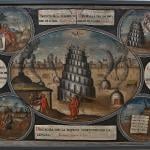 There are moments when you take stock of everyone and everything around you because you want to remember them for the rest of your life.
There are moments when you take stock of everyone and everything around you because you want to remember them for the rest of your life.
However impossible that actually is, you do it anyway. I think of it as civil disobedience against entropy, against whatever physical and chemical principles dictate the half-life of sense and memory.
I had a moment several nights ago, March 27, the debut of my friend Tearrance Chisolm’s play “In Sweet Remembrance.” It also happened to be a full moon.
I am noting the date for posterity’s sake, but also so you can verify that this wasn’t just any full moon but the Lenten Moon, or Paschal Moon, the moon the First Council of Nicea in 325 decided would always indicate the timing of Easter. I say timing, not date, because Easter is a moveable feast, always falling on the Sunday after the first full moon after the spring equinox.
The phrase “moveable feast” reminds me of Hemingway’s happy yet hardscrabble memories of living in Paris while teaching himself the discipline of being a writer: “If you are lucky enough to have lived in Paris as a young man, then wherever you go for the rest of your life, it stays with you, for Paris is a moveable feast.”
Tearrance’s play is based on the history of the college where I teach, a place that many of its alums would say is a moveable feast. It was first a plantation, but the tragic death of the owner’s daughter led the grieving mother to donate the land and wealth to found a college for women in her memory.
For three years, Tearrance plumbed the college archives. He read letters and diaries, visited graves in the slave cemetery, and hashed out possible scenarios.
The resulting script, which was given a staged reading on the night of the Lenten Moon, centers on the arrival of the first tenure-track African American professor at the college, a young woman with an Ivy League pedigree, a white husband, and a chip on her shoulder.
There has never been a tenure-track African American professor at the college, and so imagining this woman—a chemist who sees the world in terms of elements and compounds, not in terms of race and politics—forced the diverse audience of faculty, administrators, students, and local residents into a conversation about the meaningfulness of race, history, and the weight of tradition.
My daughter accompanied me. She spent the first act reading a Captain Underpants book, and the second act snoring in my lap, yet her attendance was crucial to the way the play struck me.
As we walked back to the car through venerable brick arcades, Charlotte looked over her shoulder and saw the moon caught in the branches of a tree. She wondered aloud, “When it’s big like that does that mean it’s closer to the Earth?”
My mind was still on the play and the abstractions it evoked—history, race, tradition—and so it took a moment for me to remember the physical thing we call the Earth, the physical thing we call the Moon, and the terminology of their movements: axis and revolutions, waxing and waning.
As we drove home, I did my best to explain that the Earth and Moon rotate, but the Moon gives no light of its own, reflecting that of the Sun. That night, before falling asleep, I told myself remember this night.
As a teacher of creative writing, I am constantly exhorting my students to remember, to pay attention, and to question, rewarding those who do it in the most vivid, poignant, and shapely way. Shaping is the hardest thing to teach, because the only way to learn how to do it is to get your hands dirty. Talking about it, which is what so many young writers like to do, won’t get you there.
Shaping a story—and by this I don’t just mean the sequencing of events—but rendering the intimate contours of a moment within a scene in which a character picks up the phone and receives deflating news, or when she watches a friend drive away never to be seen again.
Describing these moments takes attentiveness not just to the skin we’re in, but also to the indifferent world that doesn’t stop—though young writers, often at a loss for words, say that it seemed to, which is a lie.
Perhaps what is most difficult about teaching and understanding the act of shaping is that we can no longer assume that we each experience time the same way. It used to be that the movement of the Moon and the stars, the changing of the seasons, the blooming of bushes and flowers—like the pungent Lenten Roses lining our fence—were guideposts, a source of significance and meaning.
While there was no way for my daughter to fully understand the import of the play—a place and community coming to terms with its past, present, and future—I hope she will always remember that the spring full moon sets the date of Easter, and that there are large invisible forces at work shaping our lives.
As the years pass, that evening will lose definition, and what remains will be things that feel like truths, things I’ve always known: that reenacting the past is not so much a way of understanding how it affects the present, but that the past is still present and alive at this moment.
I write these words in the midst of the Feast of Easter, when it is easier to believe in the importance of reenactment and ritual, in hope, renewal, and, of course, resurrection.
I hope I am always to be able to call up the memory of that night. How my daughter wondered what the Moon’s closeness and brightness meant. And how I wanted to tell her, but couldn’t find the words, that it had come close so it could shed light on the truth.











